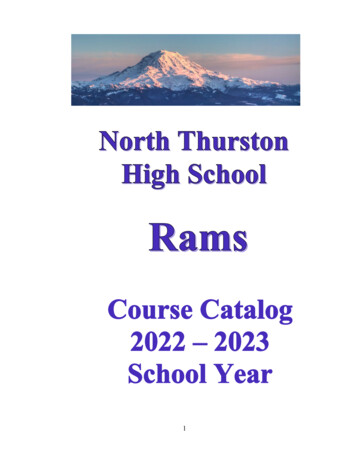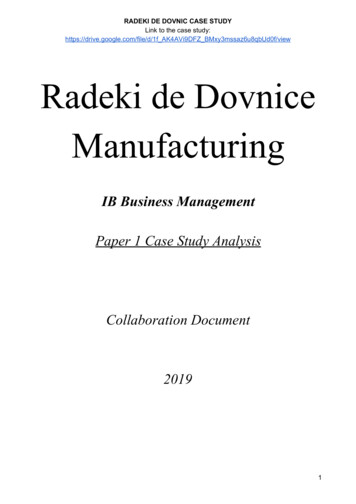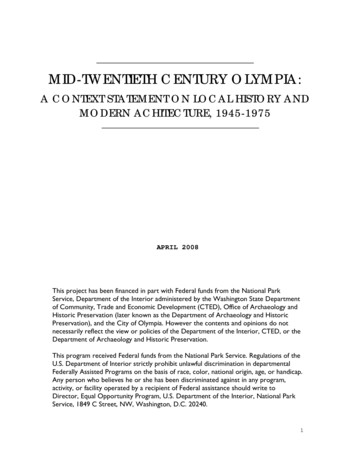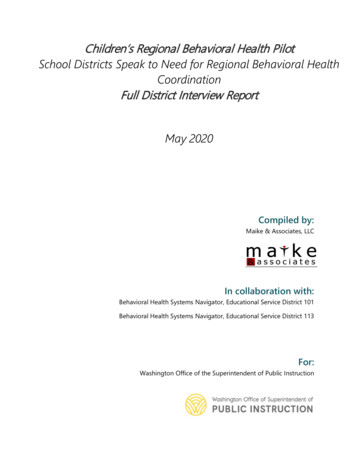
Transcription
1
IntroductionThe North Thurston High School Course Catalog is designed as a reference forstudents and parents. Use it as a guide and as a workbook for the entire 2022 - 2023school year.Start with the Graduation Requirements. Next, move to the four-year plan for yourclass. Work on this as a family, recording course and credit information for semestersyou have completed and planning for the future. Now is the time to start thinking aboutlife after high school, careers, and post-high school education options.Finally, read the course descriptions to help you select courses. If you need help,ask a teacher, your advisor, counselor, or administrator at North Thurston High School.NTHS is a great school—Make the most of it!2
Table of ContentsDescriptionPage(s)Definitions and Additional Information4-7How Do I Calculate My GPA?8Guaranteed Admissions Pilot9Graduation Pathways10Graduation Checklist / Planning Form11 – 12Cross Credit for Career and Technical Education (CTE)13Career and Technical Education (CTE)Agriculture / ScienceApplied and Business TechnologyMarketingFamily and Consumer Science 14 – 22English22 – 24Health and Fitness24 – 25Mathematics25 – 28Science28 – 31Social Studies32 – 33Visual and Performing Arts33 – 37World Languages37 – 38Support Services – ELL and Special Education39 – 41Optional Educational Experiences 41AVIDTAsRunning Start42New Market Skills Center Course Descriptions43 – 44Tech Prep4546 - 47Post High School Information3
Definitions and Additional InformationAP or Advanced PlacementAP courses follow a national curriculum and culminate in a national AP exam. Many colleges and universities awardcollege credit or course placement for students who earn successful scores on AP exams. All students who plan toattend college are encouraged to enroll in one or more AP classes while at NTHS.CADRCollege Academic Distribution Requirements: Minimum college admissions standards for Washington StatePublic 4 - year colleges and universities (Baccalaureate Institutions).Certificate of Individual AchievementA student qualifying for special education services may earn a Certificate of Individual Achievement after passingassessments determined by the student’s Individualized Education Plan (IEP) team to be appropriate for the studentbased on their learner characteristics, post-secondary goals and previous testing history.College in the High SchoolCollege is the High School is a way for juniors and seniors to earn college credit and fulfill their high school graduationrequirements, all while staying at their high school. Staff are adjunct faculty for the college/university. Studentsreceive official college transcripts. College credit can be transferred to any college in the state and most out-of-statecolleges also accept this credit. There is a fee/cost for the courses but is less expensive (75%) than regular tuition.College Entrance Exams/RequirementsThe Scholastic Aptitude Test (SAT or the American College Test (ACT) is required for students who plan to apply tofour-year colleges. Most four-year colleges have similar entrance requirements. However, students and parentsshould review individual college requirements carefully. Those requirements are available online at each collegewebsite.As a general rule, students who plan to attend a four-year college or university need to have a minimum cumulativegrade point average of 2.7 for 9th through 12th grades and good test scores on the SAT, ACT or SAT Subject Test.See your counselor for more information regarding minimum standards for specific CADRs to public baccalaureatecolleges and universities in Washington State.CreditA .5 credit is earned for each course a student successfully completes each semester. A student can earn 1.0 creditafter successful completion of a year-long course. Students in the Class of 2022 and beyond are required to earn atotal of 24 credits in specific subject areas to graduate.Credit Retrieval ProgramsPaid OptionsNTHS Summer SchoolOn-line courses:BYU Independent StudyFree OptionsBefore and after school TAThe APEX program (senior year) **NMSC Summer School (may include material fees)ORLA (Olympia Regional Learning Academy)orla@osd.wednet.edu (free if enrolled at ORLA full time)NTPS Summit Virtual Academy** The APEX program is designed to help students complete high school credits. Seniors have priority for enrollment.Students with an IEP, who need additional credits, should contact their teacher manager for information about makingup credits. Upon entrance to the program, a student will work on one subject at a time. This is in addition to theregular school day. Students completing a course will receive a grade (A-F) and .5 credits. Failure to live up to theterms of their contract will result in termination from the program with an F. Please see your counselor if you havequestionsCross Crediting / Equivalency CreditSome courses may count toward graduation requirements in more than one category. See page 12 for a list of crosscredit options.4
Dual CreditDual credit may be attained through selected CTE courses, College in the High School courses and AP classes, if thestudent passes the appropriate tests. Courses which qualify for dual credit are identified in the course description. Formore information, ask any Career and Technical Education teacher, or your counselor.ElectivesCourses chosen above and beyond minimum subject requirements.Grading PoliciesThe State of Washington has defined the following letter grades and point values to be used for reporting academicachievement on uniform, standardized state transcripts for all grades (9, 10, 11, 12):A 4.0 B 3.3 B- 2.7 C 2.0 D 1.3 F 0.0A- 3.7 B 3.0 C 2.3 C- 1.7 D 1.0P (pass) and NC (no credit) may also be used but will not count towards GPA calculation.P/F (pass/fail), W (withdrawal) or NC (no credit) requires a collaborative decision between counselor and teacher.Repeating a Course to IMPROVE a Grade:Credits are awarded at the end of each semester for classes completed with passing grades. Credits attempted for coursestaken more than once to improve a grade/mark may count only once toward the number of credits required for graduation.Credits attempted for courses taken more than once to improve a grade may count toward the number of credits required forgraduation on the condition that the letter grades earned for all attempts are included in the calculation of the student’s gradepoint average. To make a grade change, a student must submit a written request to the Registrar in the Counseling Center.WAC 392-415-055Repeating a Course for CONTINUED Study:Students may choose to repeat a course to increase their knowledge in a particular area of study. This would apply tosubject areas such as Art, Music, Fitness and CTE. A list of courses that may be repeated for additional credits is on page12. Instructor permission is required.Request to Waive a Subject Requirement:A student may apply to waive a subject requirement and can obtain an application in the Counseling Center. A completedapplication with an updated four-year education plan showing courses completed and to be taken, must be submitted to thestudent’s counselor for review. The counselor will forward the application with recommendations for approval / disapproval tothe principal who will make a final decision on the request. The student will be notified of the principal’s decision. Physicaleducation may be waived “on account of physical disability, employment, religious beliefs, or because of participation indirected athletics or military science and tactics, or for other good cause.” RCW 28A.230.050. Applications to waive arequirement must be submitted at least one semester in advance of the semester for which it is being requested. Even though a subject requirement is waived, students must still meet the minimum 24 credits required for the diploma.Late Enrollment in Courses:Students enrolling in a course prior to the 20th day of classes will be able to earn full semester credit. A studentenrolling after the 20th day of the semester will be able to earn .25 credit. After the fifth day of the second quarter,enrollment will be for no credit.High School and Beyond PlanThis is a State High School Graduation requirement, and it will be completed through Advisory. This requirementincludes: A portfolio highlighting student best works, goals, and post high school plans; 20 hours of communityinvolvement/job shadow; and a final student-led conference in the senior year.Honors Designation at GraduationThe specific grade point averages needed to earn an honors designation at graduation are as follows:Honors – 3.250 – 3.499High Honors – 3.50 – 3.749Highest Honors - 3.750 – 4.0NCAA College Athletic EligibilityThe NCAA certified athletic eligibility (GPA, SAT scores, coursework) for Division I and II athletes. If a student isconsidering participation in college sports, it is recommended that potential college athletes contact the NCAAbeginning in grade 9. You can work with your school counselor around these requirements as well.How do I contact the NCAA?5
NCAA Eligibility CenterPO Box 7136Indianapolis, IN 46207877-262-1492https://web3.ncaa.org/ecwr3/NTHS Graduation ChecklistA planning sheet for students and their parents to develop educational goals, record completed courses, chartprogress on graduation and university requirements, and plan for the year following graduation. Page 10-11.PE WaiversAll students are expected to participate in PE. NTHS provides a variety of PE classes intended to meet the needs of awide range of students; however, there are circumstances when PE may be waived.In order to qualify for a PE waiver a student must:1) Have a note from their doctor excusing them from all PE activity.Or a student must:2) be in their junior or senior year of high school,3) be enrolled in school full time, with no early release, late arrival, other free periods, or TA’s4) have a legitimate reason for being unable to take a PE class. To apply for a PE waiver, the junior or senior student must first meet with his/her Counselor to request a waiver form.Students must present a valid reason for requesting the PE waiver and they must provide a complete list of courses theyhave taken and will be taking throughout high school, including the course(s) they wish to take instead of PE. Once the waiver form is filled out in full, it must be turned in to the student's Counselor for a signature. The form is thenforwarded to an administrator who will review each request. If the administrator believes a waiver is justified, approval willbe given for the student to access the appropriate assessment, for the amount of credit they are requesting to waive.There will be three assessments available, one for each .5 credit waiver attempted. The first two assessments will bemultiple choice and the third assessment will involve the development of a fitness plan. Students will be provided with a study guide for the appropriate assessment(s) and will be given a date/time that theassessments will be offered. Once the student completes an assessment, if the score received is within passing range, thewaiver will be granted, the student will be notified, and documentation of the waiver will be posted on the student’stranscript.Personalized Pathway RequirementPathway is chosen by student based on interests and the High School and Beyond Plan. The Personalized Pathway (PP)requirements are courses that lead to a specific post-High School career or educational outcome chosen by the studentbased on the student's interests reflected in the High School & Beyond Plan.Pathways are: Path 1 – Two-year college, Path 2 – Four-year university, Path 3 – Technical/Trades, Path 4 – Military,Path 5 – Workforce.PrerequisiteThis is a course that needs to be successfully completed before taking another course. Example: To take Advanced AutoService, students must have completed the prerequisite course, Intermediate Auto.PSAT/SATThe PSAT is a preliminary test to the SAT. It is taken by juniors in the fall at each high school and is paid for by thedistrict. The PSAT helps students understand their college potential and may assist with plans for college and otherschooling. The test is also used to qualify juniors for the National Merit Scholarship.Running StartRunning Start provides an opportunity for juniors and seniors to take community and technical college classes that alsomeet high school graduation requirements. The college classes are offered tuition-free unless a student chooses anoverload schedule. Students will receive both high school credits and college credits. Courses can be taken on a fullTime or part-time basis. Five credit classes at a community college are equivalent to 1.0 high school credit. Collegecredits may be eligible for transfer to other colleges.To be eligible for Running Start, students must first meet the entrance requirements of the community or technicalcollege that they choose to attend. Students are responsible for attendance, transportation, books, and fees. SouthPuget Sound also requires a minimum 2.0 high school cumulative GPA. Anyone interested in the Running StartProgram should contact his or her counselor in the spring of their sophomore year.6
State AssessmentsWashington State High School Standardized test requirements in English, Math, and Science. Please refer to theOSPI’s website for more details on State Assessment requirements: .Teacher PlacementStudents are placed in these classes by teachers to meet graduation requirements, IEPs, etc.Teacher RecommendationA student must have a teacher recommendation to take certain courses.Transfer RequirementsThe State of Washington requires school districts to develop policies and procedures that provide parents/guardianswith the opportunity to request schools other than the resident attendance area school.North Thurston Public Schools complies with State law (RCW 28A-225,220,230,290,300 and WAC 392-137-040)which enable students the transfer options denoted below: Enrolling in the North Thurston Publics Schools while residing in another school district. Enrolling in another district while residing in North Thurston Public Schools. Enrolling in a school within the school district boundaries but outside the residence area.Both non-resident (inter-district) and resident transfer (intra-district) requests are subject to space availability anddistrict regulations. When space is available, such requests will be granted if determined to be in the best interest ofthe student. Each application will be considered on an individual basis. A decision to deny or conditionally accept atransfer request will be communicated in writing to the parent/guardian according to district timelines.What are my options if I don’t graduate with my class? Remain at school and work toward meeting your graduation requirements. K-12 public education is free tostudents until age 21. Finish your high school graduation requirements at a community or technical college. Begin college courses at a community or technical college without a high school diploma. Earn a high schooldiploma with your Associates Degree. Pursue a GED certificate. A GED is earned after passing a series of tests. Employers who hire for entry-leveljobs, college admissions officers and military recruiters, however, may view the GED as inferior to a high schooldiploma, and in some cases, an unacceptable substitute.NTHS Policy for Dropping a Class1. Students may request to drop a class within the first 5 days of the semester. After the 5th day, students may only drop aclass with administrator, teacher, counselor, and parent permission. Students who drop a class after the first 10 days of thesemester, will drop with an “F” grade and loss of credit in the class. Students are then assigned to the detention center, tobe used as a study hall (for no credit), for the remainder of the semester for that period. Drops, at this time also requireadministrative approval.2. Students who need to drop a class due to medical reasons, as verified by a medical professional, may do so.Students need to work with their counselor if applicable.3. Students who receive services through Special Education and English Language Learner programs may drop aclass if a change of placement is being made by their teacher manager. This change requires counselor/schoolpsychologist approval.4. Academically misplaced students must have teacher recommendation to drop a class. Students need to work withtheir counselor to enroll in the recommended class. After the first 10 days, this change also requires administrativeapproval.7
HOW DO I CALCULATE MY GPA?Each grade is given the following point values (called “GPA Points” on transcript):A 4.0A- 3.7B 3.3B 3.0B- 2.7C 2.3C 2.0C- 1.7D 1.3D 1.0F 0.0NC 0.0 (not used in GPA calculation)W 0.0Each course is worth a specific number of units. Most courses are 1.0 units per a year-long course. Semestercourses are worth .5 units.Step 1: Take the grade you received in your classes and multiply them by the number of units assigned to eachcourse.Example:CourseGradePoint ValueUnits AttemptedTotal Grade PointsEnglishB BiologyC (2.3)1.02.3PEB(2.7)1.02.7Total5.014.3Step 2: Add units attempted. In this case 5.0Step 3: Add grade points. In this case 14.3Step 4: GPA Total Grade Points 14.3 2.86Units Attempted 5.0HOW DO I PROJECT MY GPA?Example:* Student’s current GPA 1.94* Student’s current total units attempted (past and present) 18.0* Student is taking 3.0 units this semester* Add the 3.0 units to the 18.0 units 21* Student’s current grade points 67.7* The student’s projected grades in each class: “B” (3), “C” (2), “A” (4), “D” (1).The total grade points will be 10. Add this to the current 67.7 grade points for a total of 77.7.* The projected GPA will be: 77.7 3.7 GPA218
Guaranteed Admissions PilotNorth Thurston Public Schools is partnering with Washington’s public four-year colleges and universities in to meeting thecollege and career goals of Washington’s students. We are focused on increasing access for students who wish to attendcollege. Many of Washington’s public baccalaureate institutions offer guaranteed admissions programs for students whomeet set criteria.Washington Public Baccalaureate Institution Guaranteed Admissions ProgramsThe Guaranteed Admissions Programs supports direct admissions efforts at Central Washington University, EasternWashington University, The Evergreen State College, Western Washington University and Washington StateUniversity.All Guaranteed Admissions programs require two criteria be met for a student to be eligible: (1) A minimum GPA orminimum GPA/class ranking and (2) Completion of the College Academic Distribution Requirements (CADRs). CWU - GPA 3.0 and CADRs completion EWU - GPA 3.0 and CADRs completion Evergreen - GPA 2.5 and CADRs completion WSU - GPA 3.6 and CADRs completion. WSU Pullman is 3.0 WWU – GPA 3.0 and CADRs completionIf a student meets the criteria or is on track to meet the criteria by high school completion, he/she/they are guaranteedadmission to the institution. Students eligible for guaranteed admission must complete an admissions application andadditional requirements by the institution.How Students Can Participate in the Guaranteed Admissions PilotTo participate in the Guaranteed Admissions Pilot with the public baccalaureate institutions identified above, pleaselog into your Family Access (under online forms) and electronically sign the Guaranteed Admissions Pilot consentform or see your student’s high school counseling center for a paper consent form. Link to the district udent Information to be shared with Washington Public Baccalaureate Institutions:- First Name- Last Name- Date of Birth- Email(s) on record (to reach out to students about the opportunity)- Unweighted GPA- Transcripts- Course taking details (e.g. honors, dual credit)- Race and ethnicity9
Graduation PathwaysCareer/Technical Field CTE Course Sequence Complete 2.0 or more credits that either include a dual credit course or lead to an industryrecognized credential Complete a Core Plus programMilitary Career Interest ASVAB Exam (AFQT Section) Score for Class of 2022 31 Check the State Board of Education website by September 1 y-options/asvab)Postsecondary Education English Language Arts (ELA) andMath Courses & Exams(Can use any combination of the ELA and math options listed in this section.) ACT (ELA 14; math 16) or SAT (ELA 410; math 430) Dual credit courses (1.0 credit total): o AP/IB/Cambridge: Earn a C in state-approved course(each term)o CTE Dual Credit (must earn high school credit)o College in the High School or Running Start courses (local approval) Dual credit exams (for state-approved courses):o AP 3 o Cambridge E or bettero IB 4 State assessments:o Smarter Balanced: ELA 2548; math 2595o WA-AIM: ELA 104; math 103 Transition courses (1.0 credit total):o Bridge to College courses have state-level approvalo Local articulation agreements between districts and sponsoring collegesUpdated 8/13/202010
Student Name:NTPS High School Graduation ChecklistClass of 2022 and BeyondClass of:24 Credits Required# ofCreditsSubjectCheck When Complete(one square 0.5 Credit)Additional InformationEnglish4Math3Algebra 1, Geometry, a 3rd credit of math1Science3At least two lab sciences and a 3rd creditof science1World Studies I, II, IIIUS History1.51Civics/Government0.5World Language21.0 or 2.0 credits of World Language canbe used as part of the student’sPersonalized Pathway2Fine, Visual orPerforming Arts21.0 credit of Art can be used as part ofthe student’s Personalized Pathway2Career & TechnicalEducation1Health0.5Fitness1.5ElectivesMay be a course that meets the definition ofan exploratory course as described in theCTE program standards in RCW28A.700.0104WA State History Graduation PathwaySBAHigh School and Beyond Plan SAT/ACTAP ExamDual h1 The 3rd credit of math and the 3rd credit of science are chosen by the student, based on the student’s interest and HSBP, andapproved by the parent/guardian. If the parent/guardian is unavailable, or does not indicated a preference, the school counselor orprincipal can approve the student’s academic plan per WAC 180-51-068.2 Personalized Pathway Requirement courses lead to a specific post-high school career or educational outcome chosen by studentsbased on their interests and HSBP. The flexibility of these 3.0 credits provides students an opportunity to included career and technicaleducation courses and is intended to allow for a personalized focus for the student’s learning.11
Student Name:Class of:COURSE PLAN FOR GRADUATIONSemester 1GRADE 9Semester 2Semester 1GRADE 10Semester 2Semester 1GRADE 11Semester 2Semester 1GRADE 12Semester 2Comments: How to complete:Use this form to track the credits you have earned and those still needed for graduation.Each box is equal to .5 (one semester) because final semester grades are posted to your transcript.Example: if you pass a full year of English in 9th grade, you mark two boxes.# of credits column the number needed for graduation for each department.We encourage you to keep one of these checklists and update it at the end of each semester.Additional requirements that are not classes WA State History, High School and Beyond Plan, andGraduation Pathway.You can get more information on all requirements by meeting with your counselor.12
Cross CreditNorth Thurston High School Cross-Credit/Equivalency OptionsCourseCross-Credit OptionsAdvanced Automotive (2 period block, 2.0 cr)*.5 third year Math or 2.0 (CTE)Animal Science1.0 Science or 1.0 (CTE)Annual1.0 Fine Art or 1.0 (CTE)AP Statistics1.0 Math or 1.0 (CTE)ASL – American Sign Language1.0 World Language or 1.0 (CTE)Beginning and Intermediate Automotive (1.0 cr)*.5 third year Math or 1.0 (CTE)Beginning Web Page Design.5 Fine Art or .5 (CTE)Business English.5 English elective or .5 (CTE)Construction Skills (2 period block, 2.0 cr)*1.0 third year Math or 2.0 (CTE)Drama 1 and 21.0 English elective or 1.0 Fine ArtElectronics1.0 Science or 1.0 (CTE)Environmental Science1.0 Science or 1.0 (CTE)Horticulture.5 Science or .5 (CTE)Independent Living.5 third year Math or .5 (CTE)Journalism/Publishing1.0 English elective or 1.0 (CTE)Metal Design / Welding.5 Fine Art or .5 (CTE)Natural Resource Management-Ethnobotany1.0 Science or 1.0 (CTE)Personal Finance and Math for Business 1.5 third year Math or .5 (CTE)Personal Finance and Math for Business 2.5 third year Math or .5 (CTE)Photography 1.5 Fine Art or .5 (CTE)Photography 2.5 Fine Art or .5 (CTE)Sports Medicine1.0 Science or 1.0 (CTE)Stem Physics1.0 Science or 1.0 (CTE)Stem Earth Science1.0 Science or 1.0 (CTE)*By completing the full sequence of Automotive (3.0 credits), students may earn 1.0 Math credit.New Market Skills Center Cross-Credit OptionsSee New Market section of the catalog for this information, page 43.13
CAREER & TECHNICAL EDUCATION (CTE)AGRICULTURE/SCIENCEBEGINNING HORTICULTURE 1CTE or Science or Elective - Grades: 9-12.5 creditCourse Code: AGV101Prerequisite: NoneCollege credit available upon teacher approval (Tech Prep)In this course students will explore the skills and science of growing plants. While learning about plant growth, nutrition,propagation, heredity, plant identification, plant characteristics, and career opportunities. Students will use their knowledgeto grow plants in the school’s greenhouse. “Tech Prep Articulation” agreement allows that students who pass with a “B”grade or better may receive 5 credit hours for Hort.100 at SPSCC.ADVANCED HORTICULTURE 2CTE or Science or Elective - Grades: 9-12.5 creditCourse Code: AGV202Prerequisite: Beg. Horticulture 1In this class, students will explore horticultural science in more depth, while broadening their practical experience.Students will also explore more career opportunities in the horticultural field.ANIMAL SCIENCECTE or Science or Elective - Grades: 10-121.0 creditCourse Code: AGV121-1st semester / AGV122-2nd semesterPrerequisite: NoneThis class is designed for students interested in vocations such as Veterinary Science, Wildlife Biology, Animal ScienceTechnology, or Commercial Livestock Production. This is a “hands on” course dealing with nutrition, reproduction,endocrinology, and health practices on economically important large and small animals. Live animal judging, carcassevaluation, feedstuffs, and agricultural economics will also be covered. Students will be expected to spend extra-curriculartime dealing with field trips, animal showing, and short-term internships. Future Farmers of America activities will be anintegral part of the program.STEM PHYSICSCTE or Science - Grades: 9-111.0 creditCourse Code: SCI231-1st semester / SCI232-2nd semesterPrerequisite: NoneStem Physics is a laboratory science that examines the fundamental relationships between forces, motion, and energy inEarth and space. This class includes algebra-based problem solving, lab work, and data analysis. Students will exploreengineering and design, including the Lego Mindstorm Robotics system. Curiosity, grit, and a passion for understandingare essential as we analyze everything from the motion of galaxies to the 4 forces acting in car crashes. This course isaligned with the Next Generation Science Standards and prepares students for college readiness.ENVIRONMENTAL SCIENCECTE or Science or Elective - Grades: 10-121.0 creditCourse Code: SCI345-1st semester / SCI346-2nd semesterPrerequisite: successful completion of one science courseThis course will combine classroom and laboratory field work to explore and study the following areas: Marine resources,range environments, wildlife habitats, urban landscape, animal science, agriculture, freshwater resources, forestenvironments, vocational forestry, water quality, and environmental decisions. The opportunity to receive AP EnvironmentalScience credit will be offered to those interested. The intent of this course is to fulfill the Chemistry/Earth domain.NATURAL RESOURCECTE or Science or Elective - Grades: 10-12MANAGEMENT - ETHNOBOTANYCourse Code: AGV155-1st semester / AGV156-2nd semesterTEND, GATHER AND GROW1.0 creditPrerequisite: NoneThis course introduces students to natural resource management through the lens of Coast Salish plant traditions, basicbotany, ethnobotany, ecology, and environmental science. Based on Tend, Gather, and Grow curriculum, this courseengages students in the study of wild and cultivated plants, local landscapes, and the rich cultural traditions that surroundthem. Students will build skills in scientific observation, food security, health, social/emotional intelligence, and landstewardship.14
APPLIED TECHNOLOGYLearn about the various materials and tools that are common to many types of industrial work. Students are encouragedto try a variety of classes, as the purpose of industrial technology is to offer a wide variety of knowledge and skill.APPLIED TECHNOLOGYCTE or Science or Elective - Grades: 9-12FOR ROBOTICSCourse Code: SCI375-1st semester / SCI376-2nd semester1.0 creditPrerequisite: NoneThis course will introduce students to engineering concepts and technology design through the Lego EV3 Roboticssystem. Students learn and apply principles of Mechanical Engineering, Software Engineering, Electrical Engineering,Computer Science and Systems Design Engineering. Working in engineering teams, students use applied math andscience along with their newfound technology skills to design, build and program a variety of robots to meet challengingspecifications. No prior programmin
The North Thurston High School Course Catalog is designed as a reference for students and parents. Use it as a guide and as a workbook for the entire 2022 - 2023 . NTHS Summer School On-line courses: BYU Independent Study . Free Options . Before and after school TA The APEX program (senior year) **










